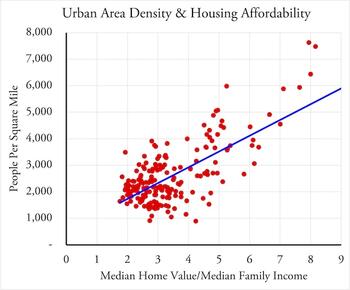
A new report on housing decries the fact that many unaffordable housing markets have gotten even less affordable in the last few years. The report’s solution is in the name of the organization that published it: Up for Growth, as in “grow up, not out.” View or download a 24MB PDF copy of this report here (link opens in new tab or window).
The reports calls for cities to identify what neighborhoods to build in, “the appropriate increase in density for each location,” and the “optimal housing mix,” in other words, the mix of single-family vs. multifamily housing, for each neighborhood. Where people actually want to live and whether they prefer to live in single- or multifamily housing are not to be considered.
Ironically, the report specifically decries the high housing prices in places like San Francisco and Seattle. Yet these cities have arguably followed the up-not-out process for several decades. The density of these two urban areas have both significantly increased since 1970. The San Francisco-Oakland urban area had less than 4,400 people per square mile in 1970; as of 2020 it was more than 6,800 people per square mile.
That increase in density was not accompanied by an increase in housing affordability. In 1970, median home prices in the Bay Area were 2.3 times median family incomes. As of 2022, prices were 7.7 times incomes. As shown in the above chart, there is a strong negative correlation between population density and housing affordability.
Read the rest of this piece at The Antiplanner.
Randal O'Toole, the Antiplanner, is a policy analyst with nearly 50 years of experience reviewing transportation and land-use plans and the author of The Best-Laid Plans: How Government Planning Harms Your Quality of Life, Your Pocketbook, and Your Future.
Photo: chart from the Antiplanner.













Density does not equal affordability
I've been involved in the development industry since 1968 both serving land developers with planning, and as an engineering and surveying technician as well as developed land. The CNU (Congress of New Urbanism) has shoved density down everyone's throat as the avenue to affordability, yet how many of their New Urbanist projects that actually got built are affordable? Some? None? In Minneapolis where I live, 5 story apartments are sprouting like weeds in this town - I'm not sure where all these new residents are coming from, but I'm not aware of any of these dense projects, that seem like a clone of each other are actually 'affordable'. Developers of course want density to increase profitability, but does that actually translate into lower cost housing? We design a lot of attainable housing - most of which is in Texas - single family at around 5 units per acre with homes still in the upper $200K range, and some newer single family promising to be even less. That's for a nice home with a two car garage and great architectural detail on organic streetscapes in which homes meander eliminating the monotony of cookie cutter development. How is that even possible? Certainly labor cost near Mexico would be a factor. Slab on grade foundations eliminate costs of a basement. These homes have arched windows, and even arched hallways. They have more architectural detail than the typical Minneapolis area new home at three times the price. Compare that with housing in Minnesota that's in the $200K price range. That get's you in an old downtrodden neighborhood that you would not want to venture out at night. Getting into a mid-rise new apartment building on the 5th floor where kids have a hallway to play will cost more per month than that new home in Texas at 1/5th the density. Cities that allow high density have raw land prices far too high. Unless they tip the scale like the slums Detroit where large areas of land can be re-developed at incredibly low cost. In Minneapolis, if a redeveloped area of single family is leveled to make room for that 5 story 'affordable' housing, then for each acre in the worst part of the city about 5 homes need to be bought out and removed. That acre will cost around $1.2 million dollars (or much more). There is no way to make that work economically unless you jam as many units as possible on that acre, and even then the numbers are not likely to work. This does happen, but most often with massive subsidies from the city - you, the tax payers.
That's building new in a bad area of town, placing more population in a very tight space. Not sure how that instills a sense of pride and self worth for the residents to be shoehorned in these monoliths. An acre of prime single family land in South Texas can be had still for $50,000 an acre, so density has less of a factor. Newer planning methods can reduce the cost of infrastructure between 20% and 30% which is more of a factor in many cases than the cost of the land. Less infrastructure while maintaining density = more greenspace, livability, and less environmental impacts.
Texas advantage?
Would like to hear what the "new planning methods" are that aren't used in other jurisdictions. But the raw land cost does still seem to be the overriding issue.